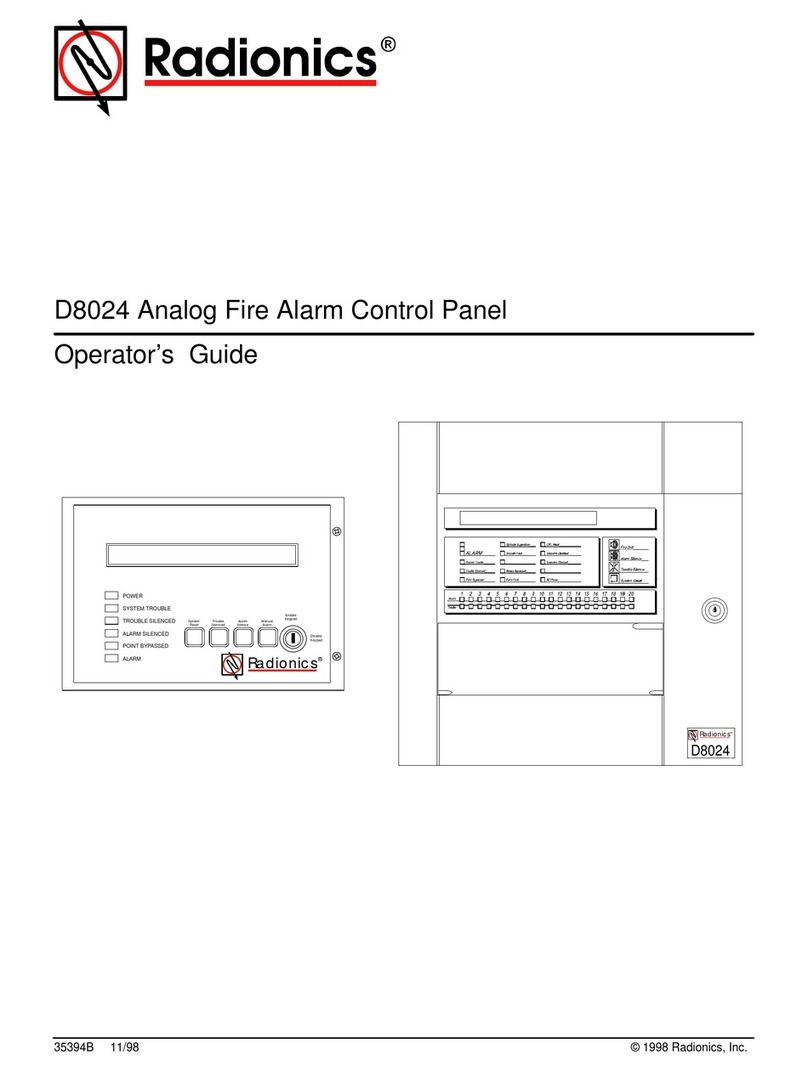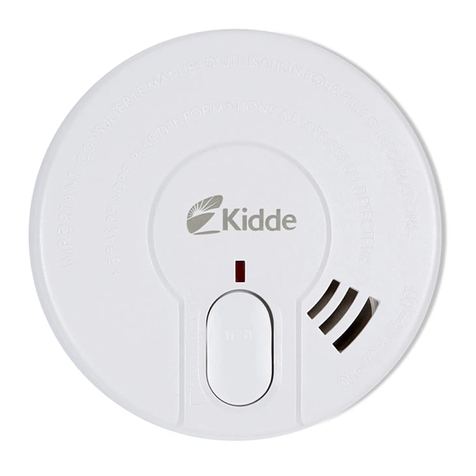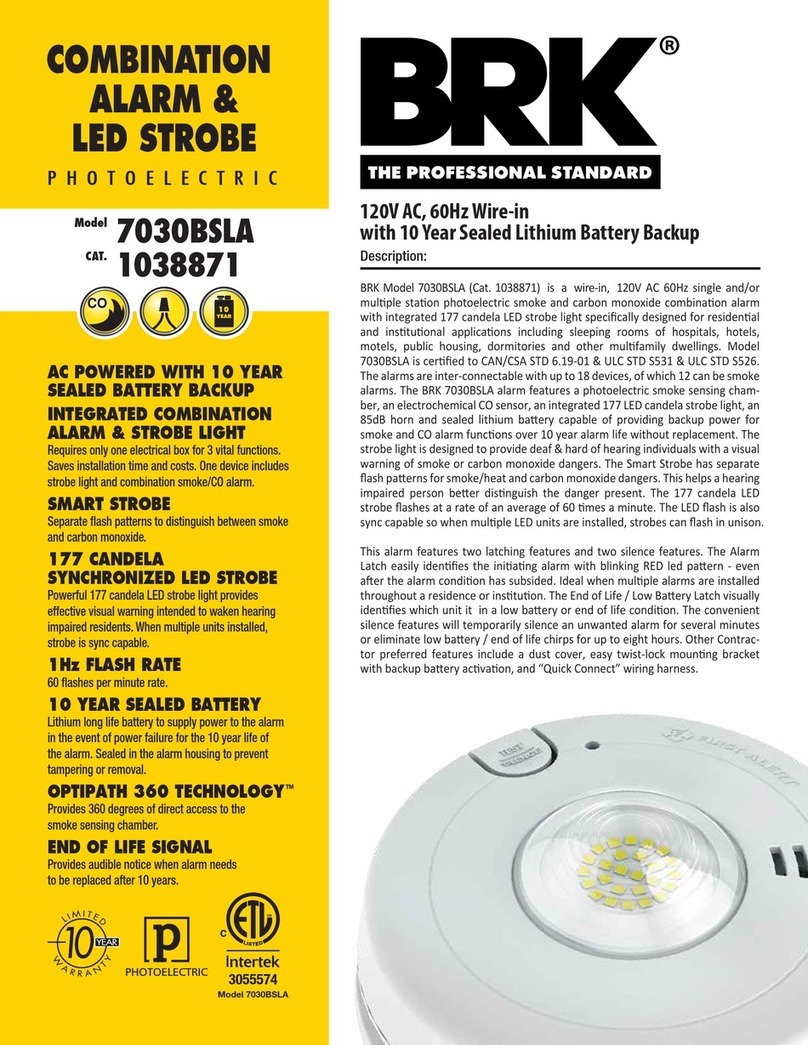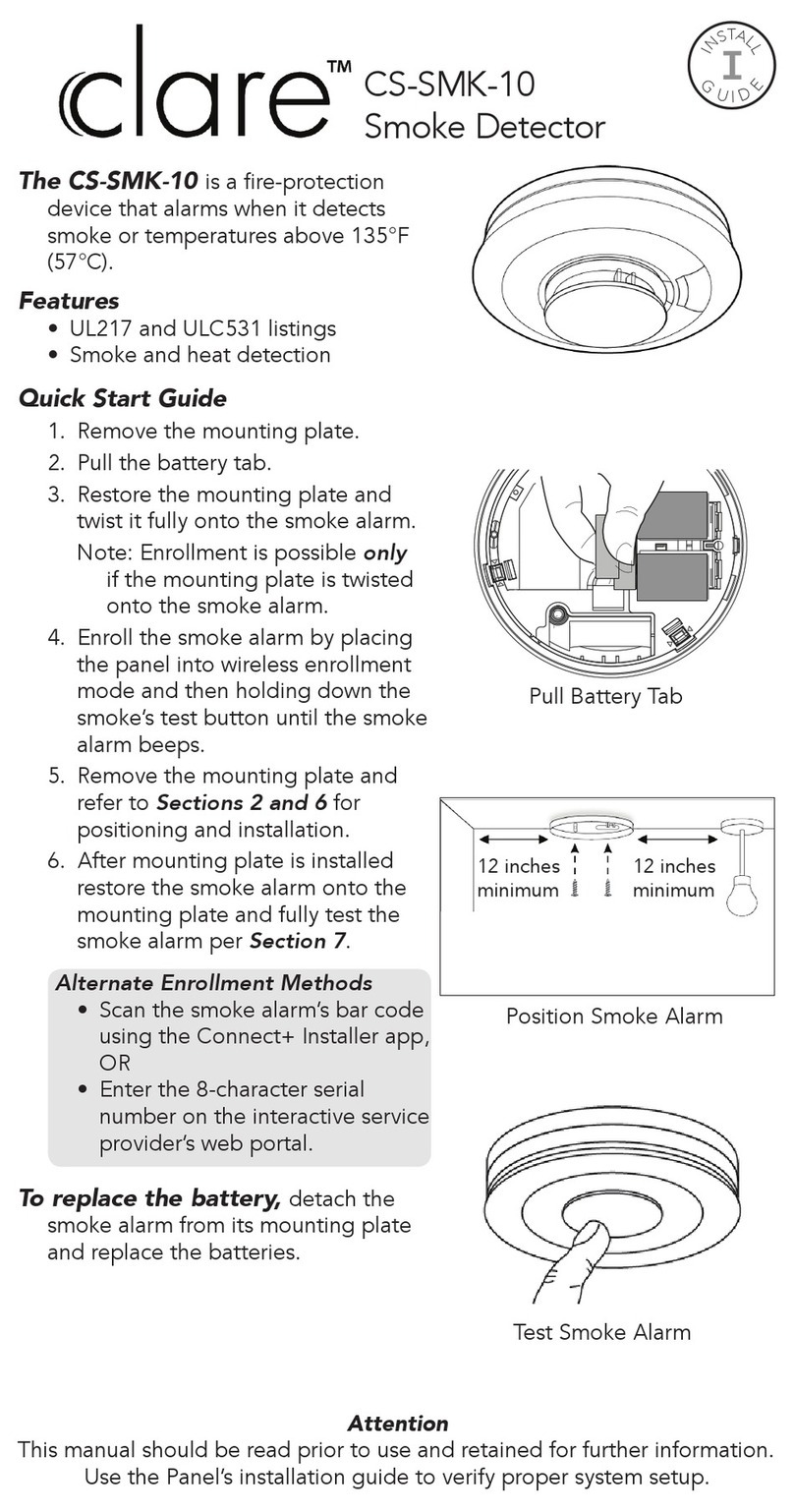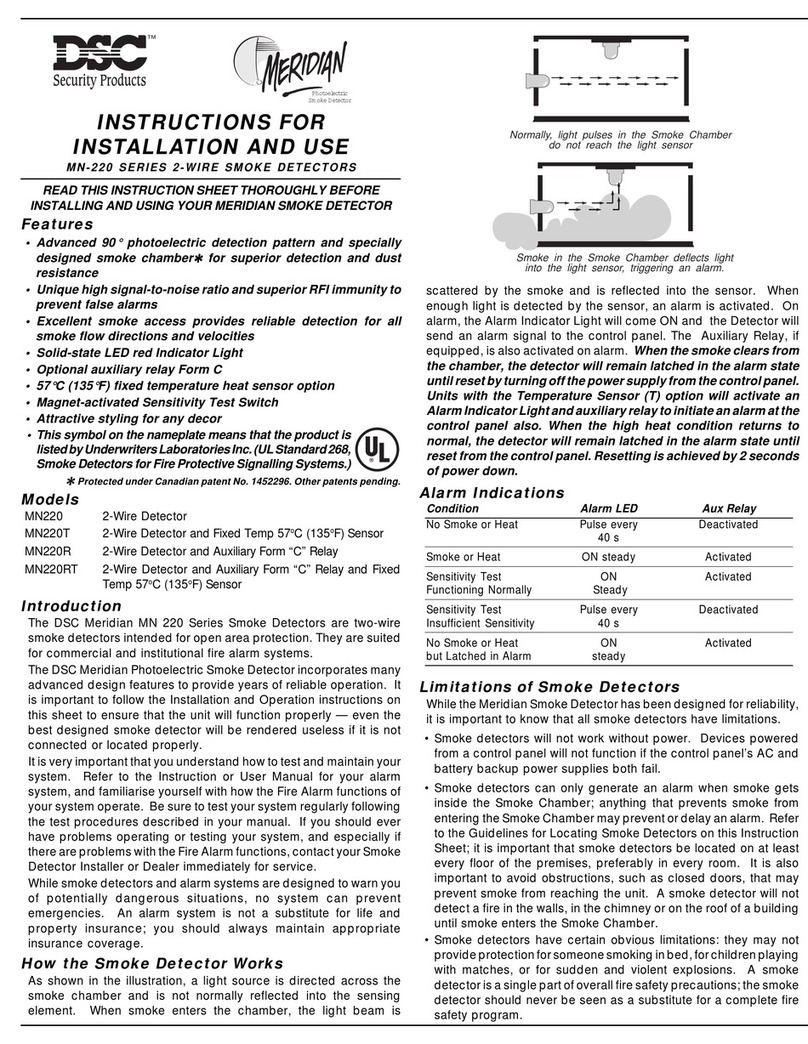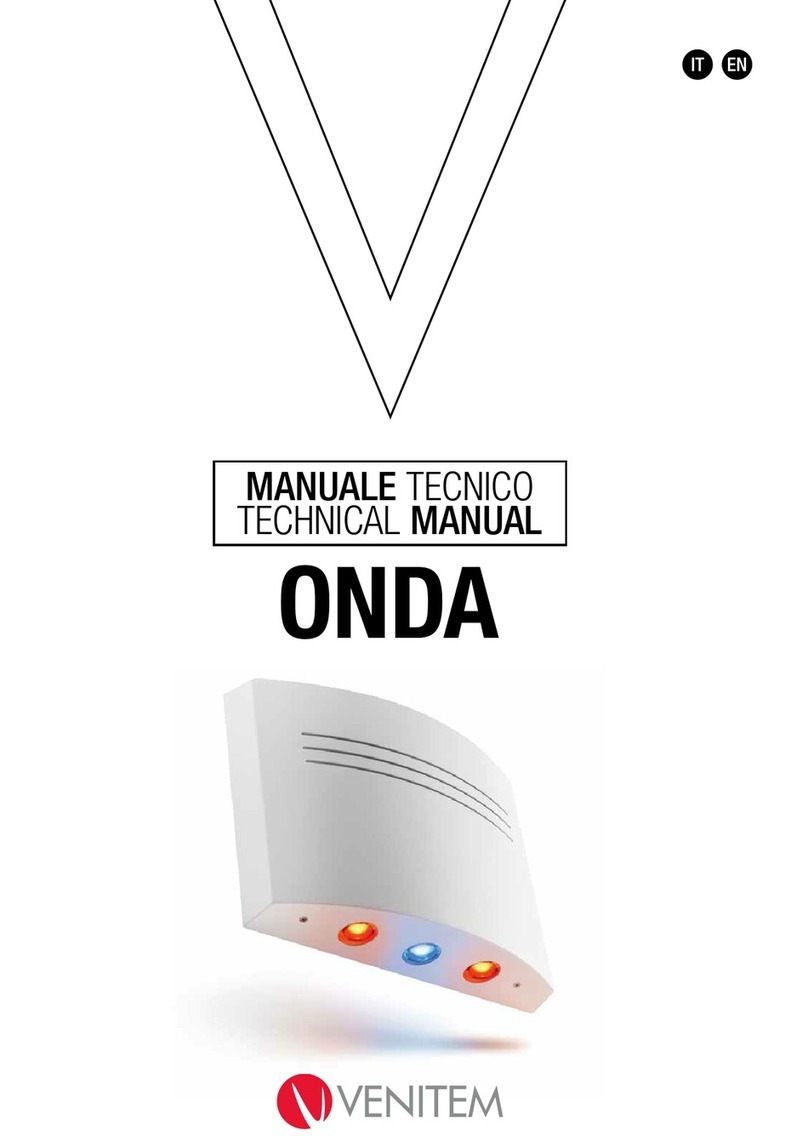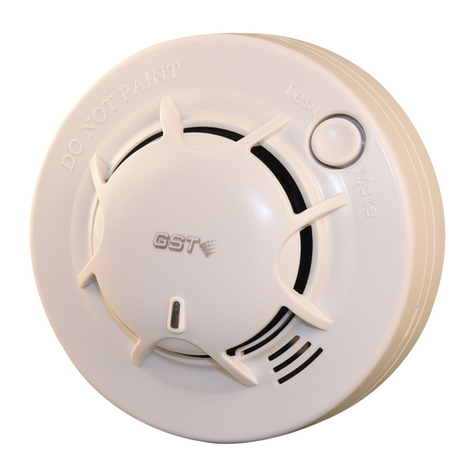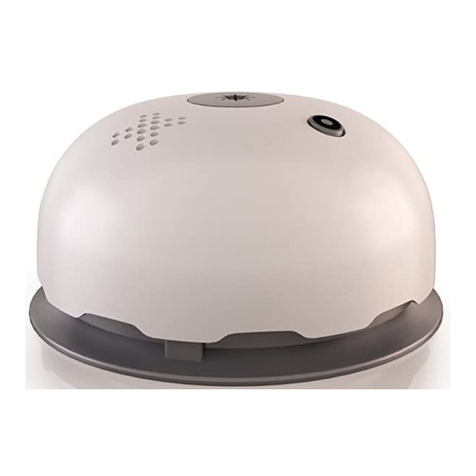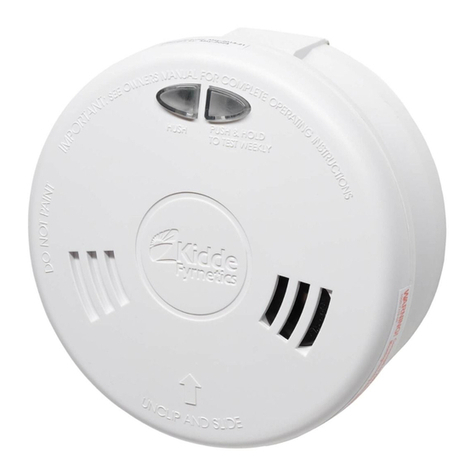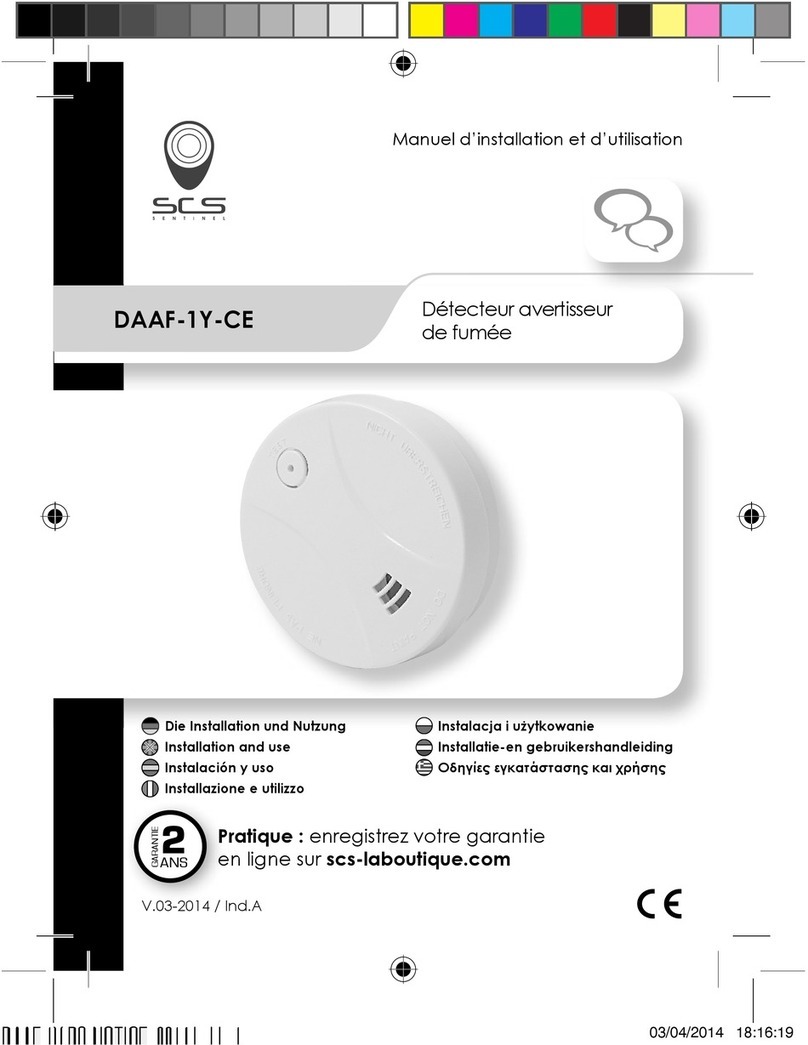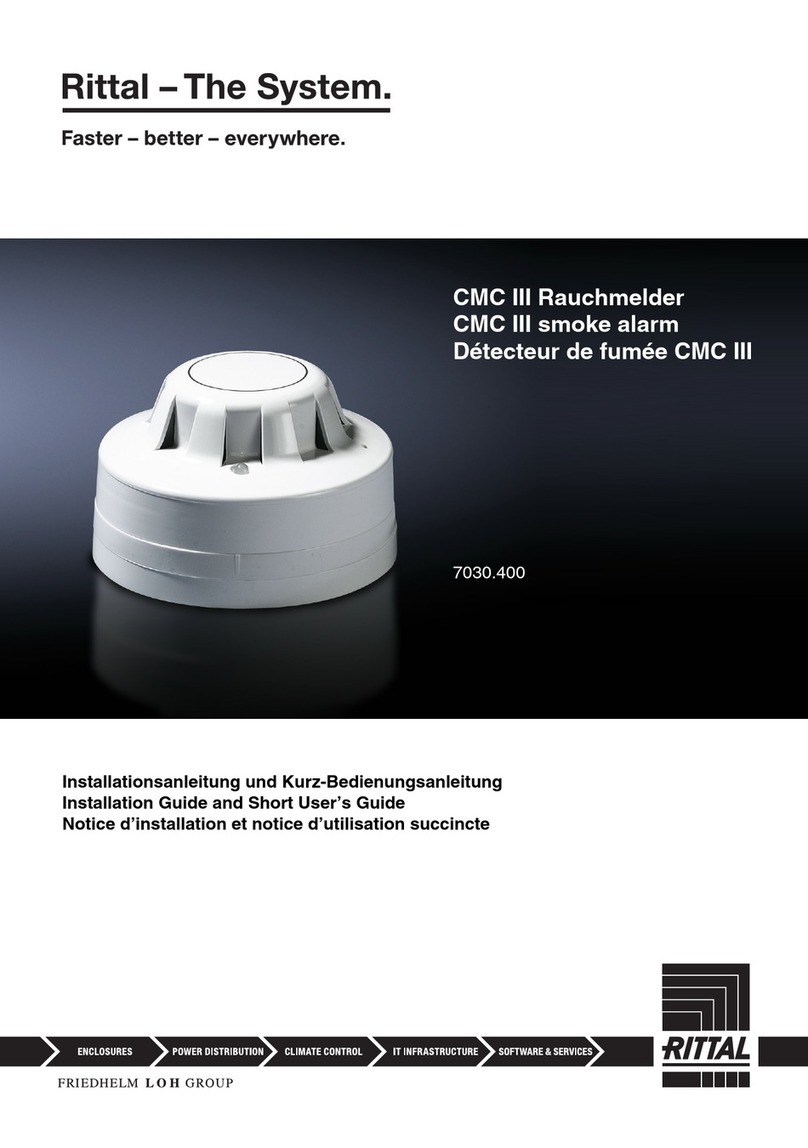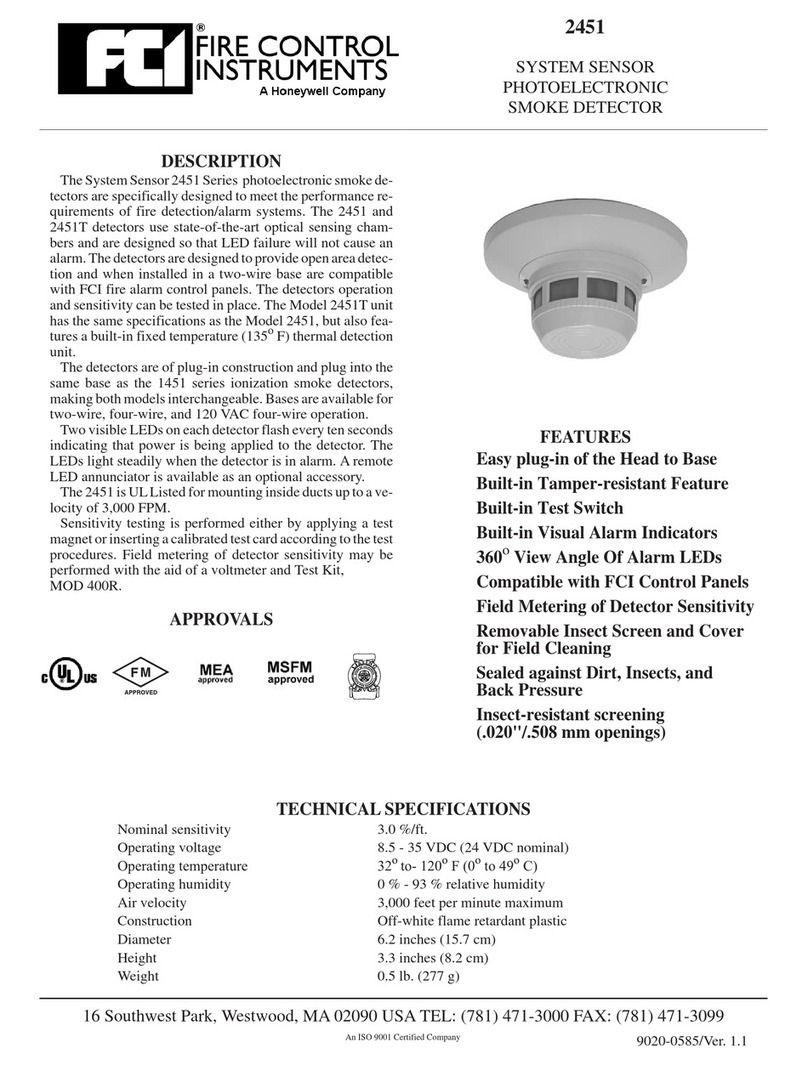United Technologies Kidde P4010ACSCO-WCA User manual

1
WIRELESS
Hardwire Photoelectric Smoke & Carbon Monoxide Alarm
with Voice and Wireless Interconnect
User Guide
Model P4010ACSCO-WCA
WIRELESS INTERCONNECT:
You do NOT need a home wi-fi system
to use these units. Multiple wireless
units create their own independent
wireless alarm network.
120 V HARDWIRE
10YEAR BATTERY BACKUP
HARDWIRE & WIRELESS
INTERCONNECT
VOICE ALARM
COMBINATION ALARM

2
Thank You for Purchasing this Kidde Alarm
Hardwired for 120V AC, this model features a non-replaceable, sealed-in battery backup. It also contains
a voice message system and Hush®Control to temporarily silence nuisance alarms. It is capable of both
Hardwire and Wireless Interconnect.
READ SECTION 9: Activation and Wireless Alarm Network, before powering the units. You do
NOT need a home wi-fi system to use these units. Multiple wireless units create their own
independent wireless alarm network.
Teach children how to respond to the alarm and that they should never play with the unit. This alarm is a
multi-criteria device designed to detect both smoke and carbon monoxide from any source of combustion in
a residential environment. It is not designed for use in a recreational vehicle (RV) or boat.
NOTE: Please take a few minutes to thoroughly read this user guide which should be saved for future
reference and passed on to any subsequent owner.
The National Fire Protection Association (NFPA) and the manufacturer recommend replacing this alarm ten
years from the date code on back of alarm.
Date Code (on back): ___________________
Date of Purchase: ___________________
Where Purchased: ___________________
Date to Replace: ___________________
Product Support: 1-800-880-6788
Please write down the below information
and have this at hand when you call.

3
Contents
1. Smoke Alarm: What To Do When The Alarm Sounds . . . . . . . . . . 4
2. Carbon Monoxide Alarm: What To Do When The Alarm Sounds . . . . . . 5
3. Other Alarm Visual And Audible Indicators . . . . . . . . . . . . . .6
4. Troubleshooting Guide . . . . . . . . . . . . . . . . . . . . . 7
5. Introduction, Product Features & Specifications . . . . . . . . . . . . 8
6. Limitations Of Smoke And Carbon Monoxide Alarms . . . . . . . . . . 9
7. Recommended Locations For Smoke Alarms . . . . . . . . . . . . . 11
8. Locations To Avoid . . . . . . . . . . . . . . . . . . . . . . .13
9. Activation And Wireless Alarm Network . . . . . . . . . . . . . . . 13
9.1 Setting Up A Wireless Alarm Network. . . . . . . . . . . . . . . 14
9.2 Adding Another Device to an Existing Wireless Alarm Network . . . . . 15
9.3 Resetting a Device’s Wireless Settings . . . . . . . . . . . . . . 17
10. Wiring Instructions . . . . . . . . . . . . . . . . . . . . . . 18
11. Operation And Testing . . . . . . . . . . . . . . . . . . . . . 22
12. Recognizing Nuisance Alarms . . . . . . . . . . . . . . . . . . 23
13. Battery Back Up. . . . . . . . . . . . . . . . . . . . . . . . 25
14. Permanently Disable Alarm / Discharge Battery . . . . . . . . . . . . 26
15. General Carbon Monoxide (CO) Information . . . . . . . . . . . . . 27
16. Cleaning Your Alarm . . . . . . . . . . . . . . . . . . . . . .30
17. Good Safety Habits . . . . . . . . . . . . . . . . . . . . . . 31
18. Service And Warranty . . . . . . . . . . . . . . . . . . . . . 34

4
1. Smoke Alarm: What To Do When the Alarm Sounds
Smoke alarm pattern is three long beeps with voice “Fire!,” a 1.5 second pause, and three long beeps repeating.
The red LED blinks in time with alarm pattern.
The smoke alarm takes precedence when both smoke and carbon monoxide are present.
•Alert small children in the home as well as anyone else that might have difficulty recognizing the
importance of the alarm sounding or that might have difficulty leaving the area without help.
•Leave immediately by your escape plan. Every second counts, so don’t waste time getting dressed or
picking up valuables.
•In leaving, don’t open any inside door without first feeling its surface. If hot, or if you see smoke seeping
through cracks, don’t open that door! Instead, use your alternate exit. If the inside of the door is cool,
place your shoulder against it, open it slightly and be ready to slam it shut if heat and smoke rush in.
•If the escape route requires you to go through smoke, stay close to the floor where the air is cleaner.
Crawl if necessary, and breathe shallowly through a cloth, wet if possible.
•Once outside, go to your selected meeting place and make sure everyone is there.
•Call the fire department from your cell phone outside, or from your neighbour’s home—not from yours!
•Don’t return to your home until the fire officials say that it is all right to do so.
•There are situations where a smoke alarm may not be effective to protect against fire as stated in the
NFPA Standard 72. For instance:
a) smoking in bed
b) leaving children home alone
c) cleaning with flammable liquids, such as gasoline
NOTE: See Section 12. RECOGNIZING NUISANCE ALARMS, for nuisance alarm situations.

5
2. Carbon Monoxide Alarm: What To Do When the Alarm Sounds
Carbon monoxide (CO) alarm pattern is four quick beeps with voice “Warning! Carbon Monoxide” repeating
every 5 seconds. The red LED blinks in time with alarm pattern.
WARNING: CARBON MONOXIDE ALARM ACTIVATION INDICATES THE PRESENCE
OF CARBON MONOXIDE (CO) AT HIGH CONCENTRATIONS WHICH CAN KILL YOU.
1. Immediately move to fresh air – outdoors or by an open door/window. Do a head count to check
that all persons are accounted for. Do not re-enter the premises nor move away from the open door/
window until the emergency services responders have arrived, the premises have been aired out, and
your alarm remains in its normal condition.
2. Call your local emergency service.
(fire department or 911)
Never restart the source of a CO problem until it has been corrected. Never ignore the sound of the alarm!
NOTE: See Section 12. RECOGNIZING NUISANCE ALARMS, for nuisance alarm situations.
PHONE NUMBER

6
3. Other Alarm Visual and Audible Indicators
Operational Mode Visual Indications Audible Indications Action/Note:
Normal (standby) AC power: Green LED on continuously
during light conditions, or blink every
60 sec during dark conditions.
DC power: Green LED blink approx
every 60 sec.
Test (button press when
no alarm condition is
present)
• 4 patterns of Red/Amber/Green.
• Test: Red LED blinks in time with alarm
pattern.
• Green LED fade on/o at test complete
• Button press sound
• Voice: "Testing, this is very loud.
Press now to cancel test. 5, 4, 3, 2, 1."
• 3 long beeps, Voice "Fire!",
3 long beeps, 4 quick beeps, Voice
"Warning, Carbon Monoxide,"
4 quick beeps, Voice "Test
Complete," Power on/reset sound.
• Voice "Test Canceled" if button
pushed before test sequence
begins.
Perform Test/Hush button press
once a week to verify proper alarm
operation
* Push/release button before the
countdown ends to cancel test.
Smoke or CO Alarm
Memory (unit has
experienced a smoke or
CO alarm event within the
last hour)
Red and Amber LED alternate on 1 sec,
every 10 sec.
After button push: "Smoke previously
detected" or "Carbon Monoxide
previously detected" only on the
initiating alarm unit.
Push test button to clear Alarm
Memory. NOTE: standard test
sequence will follow. (Push/release
button again to cancel test).
Smoke Alarm Hush Mode,
(Hush®
Control)
Red LED blinks every 2 sec. After button push: "Hush Mode Acti-
vated." Smoke alarm pattern stops.
(If there is too much smoke to allow
Hush: Voice "Too Much Smoke, Alarm
cannot be Hushed" Smoke alarm
pattern continues.)
This feature is to be used only
when a known alarm condition,
such as smoke from cooking,
activates the alarm.
CO alarm reset None After button push: CO alarm pattern
stops.
Unit is conrming if CO is present
or if it experienced a nuisance
situation. Re-alarm means danger.
Move to fresh air and call 911.
Locate None After button push on non-initiating
unit, only initiating unit continues
alarm pattern.
Use this to quickly locate the alarm
source and determine if alarm is
nuisance or real.
Smoke Alarm Hush Mode
Canceled
None Voice message "Hush Mode
Canceled."
When smoke levels drop below the
alarm threshold, the voice message
"Hush Mode Canceled" will occur .
Initiating Alarm,
(Multiple alarms in an
interconnected system)
Green LED blinks once per sec indicating
that this is the unit initiating the alarm
in an interconnected, multiple alarm,
system.
Unit in either Smoke or CO alarm
mode.
During alarm, the initiating alarm
red blink will be interrupted by a
green blink.

7
4. Troubleshooting Guide
Trouble Condition Visual Indications Audible Indications Action:
Low Battery
Amber
LED
blinks
every
5
seconds
Chirp every 60 sec, voice every
30 sec: “Replace alarm.”
Voice stops after 5 mins.
* Remove, discharge, dispose unit, and replace as soon
as possible.
Fault Mode Chirp every 30 sec.
Voice every 30 sec: “Error, see trouble
shooting guide”
After 5 mins: no voice message
* See Cleaning Your Alarm section.
* Push Test/Hush button once to attempt to reset
the unit .
* Red LED will blink out an error code (number of blinks)
when Test/Hush button is push/released once. Report
the number of blinks to customer service if needed.
End of Unit Life Double chirp every 30 sec.
First 5 mins: Voice every 30 sec:
“Replace alarm, press button to
temporarily silence.” Voice stops after
5 mins. After 7 days: Chirps continue.
Voice every 30 sec for 5 mins:
“Replace alarm.”
* Push/release Test/Hush button to temporarily silence
(see End of Unit Life Hush Mode section below)
* Remove, discharge, dispose unit, and replace as soon
as possible.
End of Unit Life Hush
Mode (after push/
release Test/Hush
button during End
of Life)
Voice “Temporarily Silenced.”
End of Unit Life chirps silenced for
24 hrs. (7 days after End of Unit Life
chirps begin, the chirps cannot be
silenced.)
* Remove, discharge, dispose unit, and replace as soon
as possible.
Network Error Chime every 30 secs. Voice every
30 sec: “Connection lost. Press
button to temporarily silence.”
After 5 min: no voice messages
(Note: network must have 3 or more
alarms for voice messages.)
* Push/release the Test/Hush button once to silence for
24 hrs at a time.
* Red LED will blink out an error code (number of blinks)
when Test/Hush button is push/released once. Report
the number of blinks to customer service if needed.
* Push and hold Test/Hush button until two beeps
are heard (approx 4 sec) and then release the button
to try to rejoin. Or reset (section 9.3) and then rejoin
(section 9.2).
* If error persists, remove, discharge, and replace alarm
as soon as possible.
Network Error Hush
(after button push
during Network Error)
Voice “Temporarily
Silenced.”
If you require further information please contact Product Support at 1-800-880-6788 or write us at:
Kidde Canada Inc., P.O. Box 40, Apsley, ON K0L 1A0. Our internet address is www.kiddecanada.com.

8
5. Introduction, Product Features and Specifications
INTRODUCTION
This alarm detects products of combustion using photoelectric technology and carbon monoxide using an
electrochemical cell. Many times throughout this User Guide, we will refer to Carbon Monoxide as “CO.” Ten (10)
years after the unit is installed, this unit will automatically alert you that it is time to replace the unit. This is called
“End of Unit Life” mode. See Troubleshooting Guide. To help identify the date to replace the unit, a label has
been affixed to the side of the alarm. Write in the “Replace by” date (10 years from initial power up) in permanent
marker on the label prior to installing the unit.
NOTE: AC power must be connected to obtain the full 10 year battery and unit life.
PRODUCT FEATURES AND SPECIFICATIONS:
•Temperature: Operating Range: 4.4°C (40°F) to 37.8°C (100°F)
•Humidity: Operating range: 10-95% RH non-condensing
•Audible Alarm: 85+ dB at 10’ 3.0 to 3.5 KHz pulsing alarm, with voice messages
“Fire!” and/or “Warning! Carbon Monoxide.”
•Smoke Sensor: Photoelectric
•CO Sensor: Electrochemical
•Voice message system
•Smoke Alarm Hush®Control
•Ambient Light Sensing
•Powered by 120 V AC (60 Hz, 53 mA max) wire-in connector with sealed lithium battery backup.
•Hardwire and wireless interconnectable to other compatible alarms.
•One large, user- friendly button.

9
6. Limitations of Smoke and Carbon Monoxide Alarms
WARNING: PLEASE READ CAREFULLY AND THOROUGHLY
•Life safety from fire in residential occupancies is based primarily on early notification to occupants of the
need to escape, followed by the appropriate egress actions by those occupants.
•Fire warning systems for dwelling units are capable of protecting about half of the occupants in
potentially fatal fires. Victims are often intimate with the fire, too old or young, or physically or mentally
impaired such that they cannot escape even when warned early enough that escape should be possible.
For these people, other strategies such as protection-in-place or assisted escape or rescue are necessary.
•Leading authorities recommend that both ionization and photoelectric smoke alarms be installed to
help insure maximum detection of the various types of fires that can occur within the home. Ionization
sensing alarms may detect invisible fire particles (associated with fast flaming fires) sooner than
photoelectric alarms. Photoelectric sensing alarms may detect visible fire particles (associated with slow
smoldering fires) sooner than ionization alarms.
•A battery powered alarm must have a battery of the specified type, in good condition and installed
properly (This model has a sealed backup battery).
•Smoke alarms must be tested regularly to make sure the battery and the alarm circuits are in good
operating condition.
•Smoke alarms cannot provide an alarm if smoke does not reach the alarm. Therefore, smoke alarms may
not sense fires starting in chimneys, walls, on roofs, on the other side of a closed door or on a different
floor.
•If the alarm is located outside the bedroom or on a different floor, it may not wake up a sound sleeper.
•The use of alcohol or drugs may also impair one’s ability to hear the smoke alarm. For maximum
protection, a smoke alarm should be installed in each sleeping area on every level of a home.
This alarm is not intended to alert hearing impaired individuals.

10
WARNING: PLEASE READ CAREFULLY AND THOROUGHLY
•IMPORTANT: This alarm is designed to detect carbon monoxide gas from ANY source of combustion. It is
NOT designed to detect any other gas.
CAUTION: This alarm will only indicate the presence of carbon monoxide gas at the sensor. Carbon
monoxide gas may be present in other areas. Never restart the source of a CO problem until it has been
fixed. NEVER IGNORE THE ALARM!
•Industry experts recommend a CO alarm be installed on each level of the home—ideally on any level
with fuel burning appliances and outside of sleeping areas.
WARNING: THIS PRODUCT IS INTENDED FOR USE IN ORDINARY INDOOR LOCATIONS OF
FAMILY LIVING UNITS. IT IS NOT DESIGNED TO MEASURE COMPLIANCE WITH COMMERCIAL OR
INDUSTRIAL STANDARDS. IT IS NOT SUITABLE FOR INSTALLATION IN HAZARDOUS LOCATIONS
AS DEFINED IN THE LOCAL BUILDING CODE. IT IS NOT DESIGNED FOR USE IN A RECREATIONAL
VEHICLE RV OR BOAT.
•The installation of this device should not be used as a substitute for proper installation, use, and
maintenance of fuel burning appliances, including appropriate ventilation and exhaust systems.
•This alarm does not prevent CO from occurring, nor can it solve any existing CO problem.
WARNING: THIS DEVICE IS DESIGNED TO PROTECT INDIVIDUALS FROM ACUTE EFFECTS OF
CARBON MONOXIDE EXPOSURE. IT MAY NOT FULLY SAFEGUARD INDIVIDUALS WITH SPECIFIC
MEDICAL CONDITIONS. IF IN DOUBT, CONSULT A MEDICAL PRACTITIONER. INDIVIDUALS WITH
MEDICAL PROBLEMS MAY CONSIDER USING WARNING DEVICES WHICH PROVIDE AUDIBLE AND
VISUAL SIGNALS FOR CARBON MONOXIDE CONCENTRATIONS UNDER 30 PPM.
•This alarm has not been investigated for carbon monoxide detection below 70 PPM.
•This combination smoke and carbon monoxide alarm requires a continuous supply of electrical power –
it will not work without power.

11
7. Recommended Locations for Smoke Alarms
•Locate smoke alarms in all sleeping areas. Try to monitor the exit path as the bedrooms are usually farthest
from the exit. If more than one sleeping area exists, locate additional alarms in each sleeping area.
•Locate additional alarms to monitor any stairway as stairways act like chimneys for smoke and heat.
•Locate at least one alarm on every floor level.
•Locate an alarm in every bedroom.
•Locate an alarm in every room where electrical appliances are operated (i.e. portable heaters or humidifiers).
•Locate an alarm in every room where someone sleeps with the door closed. The closed door may
prevent an alarm not located in that room from waking the sleeper.
•Smoke, heat, and combustion products rise to the ceiling and spread horizontally. Mounting the smoke
alarm on the ceiling in the center of the room places it closest to all points in the room. Ceiling mounting
is preferred in ordinary residential construction.
ANYWHERE ALONG
THIS BOLD SURFACE
Locations permitted for smoke
alarms and smoke detectors
on tray-shaped ceilings.
(4")
10cm
(4")
10cm
(12")
30.5
cm
(12")
30.5cm
(3')
0.9m
(3')
0.9m
(3')
0.9m
ANYWHERE ALONG
THIS BOLD SURFACE
Locations permitted for smoke
alarms and smoke detectors
on tray-shaped ceilings.
(4")
10cm
(4")
10cm
(12")
30.5cm
(12")
30.5cm
(3')
0.9m
(3')
0.9m
(3')
0.9m
ANYWHERE ALONG
THIS BOLD SURFACE
Locations permitted for smoke
alarms and smoke detectors
on tray-shaped ceilings.
(4")
10cm
(4")
10cm
(12")
30.5cm
(12")
30.5cm
(3')
0.9m
(3')
0.9m
(3')
0.9m
ANYWHERE ALONG
THIS BOLD SURFACE
Locations permitted for smoke
alarms and smoke detectors
on tray-shaped ceilings.
(4")
10cm
(4")
10cm
(12")
30.5cm
(12")
30.5cm
(3')
0.9m
(3')
0.9m
(3')
0.9m
ANYWHERE ALONG
THIS BOLD SURFACE
Locations permitted for smoke
alarms and smoke detectors
on tray-shaped ceilings.
(4")
10cm
(4")
10cm
(12")
30.5cm
(12")
30.5cm
(3')
0.9m
(3')
0.9m
(3')
0.9m
ANYWHERE ALONG
THIS BOLD SURFACE
Locations permitted for smoke
alarms and smoke detectors
on tray-shaped ceilings.
(4")
10cm
(4")
10cm
(12")
30.5cm
(12")
30.5cm
(3')
0.9m
(3')
0.9m
(3')
0.9m
NFPA 72 states: “Smoke alarms in rooms with
ceiling slopes greater than 0.3 m in 2.4m (1ft in 8 ft)
horizontally shall be located on the high side of the
room.” NFPA 72 states: “A row of detectors shall be
spaced and located within 0.9 m (3 ft) of the peak of
the ceiling measured horizontally.”
Figure 7-A
Figure 7-B Figure 7-C

12
•For mobile home installation, select locations carefully to avoid thermal barriers that may form at the
ceiling. For more details, see MOBILE HOME INSTALLATION section.
•When mounting an alarm on the ceiling, locate it at a minimum of 10 cm (4") from the side wall.
•When mounting the alarm on the wall, use an inside wall with the top edge of the alarm at a minimum of
10 cm (4") and a maximum of 30.5 cm (12") below the ceiling.
•Put smoke alarms at both ends of a bedroom hallway or large room if the hallway or room is more than
9.1 m (30 ft) long.
•Install Smoke Alarms on sloped, peaked or cathedral ceilings at or within 0.9m (3 ft) of the highest point
(measured horizontally).
This equipment should be installed in accordance with the National Fire Protection Association’s 72 (National
Fire Protection Association, Batterymarch Park, Quincy, MA 02269).
MOBILE HOME INSTALLATION
Modern mobile homes have been designed and built to be energy efficient. Install smoke alarms as
recommended on the previous page. In older mobile homes that are not well insulated compared to present
standards, extreme heat or cold can be transferred from the outside to the inside through poorly insulated
walls and roof. This may create a thermal barrier which can prevent the smoke from reaching an alarm
mounted on the ceiling. In such units, install the smoke alarm on an inside wall with the top edge of the alarm
a minimum of 10 cm (4”) and a maximum of 30.5 cm (12”) below the ceiling.
If you are not sure about the insulation in your mobile home, or if you notice that the outer walls and ceiling
are either hot or cold compared to the room air temperature, install the alarm on an inside wall. For minimum
protection install at least one alarm close to the bedrooms.
WARNING: TEST YOUR ALARM OPERATION AFTER MOBILE HOME HAS BEEN IN STORAGE OR
UNOCCUPIED, AND AT LEAST ONCE A WEEK DURING USE.

13
8. Locations to Avoid
•In the garage. Products of combustion are present when you start your automobile.
•Normal cooking may cause nuisance alarms. If a kitchen alarm is desired, it should have an alarm silence
feature or be a photoelectric type.
•Do not install within 1.8 m (6 ft) of heating or cooking appliances.
•Less than 10cm (4”) from the peak of an “A” frame type ceiling.
•In an area where the temperature may fall below 4.4°C (40°F) or rise above 37.8°C (100°F), such as garages
and unfinished attics.
•In dusty areas. Dust particles may cause nuisance alarm or failure to alarm.
•In very humid areas (above 95% RH, non-condensing). Moisture or steam can cause nuisance alarms.
•In insect-infested areas.
•Smoke alarms should not be installed within 0.9m (3ft) of the door to a bathroom containing a tub or shower, forced
air supply ducts used for heating or cooling, ceiling or whole house ventilating fans, or other high air flow areas.
•Near lights. Electronic “noise” generated by the electronics may cause nuisance alarms.
•Do not install near vents, flues, chimneys or any forced/unforced air ventilation openings.
•Do not install near fans, doors, windows or areas directly exposed to the weather.
9. Activation and Wireless Alarm Network
Upon initial power being applied (from rotating onto mounting
plate or moving the red activation wheel to the “ON” position - see
Figure 9.1-B) these units are ready to connect to a network.
Figure 9.1-B
ON
ACTIVATION
TOOL

14
NOTE: At any time during wireless alarm network setup, if you have a problem, you can push and hold
the Test/Hush button on any problem unit until you hear three (3) beeps (approx 8 sec), and then release
the button. The unit will reset the unit’s wireless settings (described in Section 9.3). Once wireless network
settings are reset, the unit will prompt the user to follow Quickstart instructions.
9.1 Setting Up a Wireless Alarm Network
Creating an interconnected wireless alarm network is a simple process, with intelligent “self-enrollment”
features, and user-friendly voice prompts.
A. REMOVE ALL DEVICES FROM THEIR PACKAGING
B. POWER UP ALL DEVICES
•Locate the red wheel on the back of the device. Turn the red wheel to the “ON” position on ALL devices
using the white tool included with the Quick Start Guide.
•Once powered, the light rings will glow red and voice message will announce, “Ready to connect. Follow
Quick Start instructions.”
C. LANGUAGE SELECTION
•This unit operates in either English or French. To switch your language preference at any time, press the Test
button twice on ALL devices you wish to connect. You should hear one beep for each button press, followed
by a voice message confirming your language selection (“English language selected” or “Langue française
selectionné”). If no language is selected, the voice prompts will continue in the default / set language.
NOTE: If no further steps are taken within 15 minutes of initial power up, a voice prompt, “No devices
found, not connected” will be heard once, and the wireless function will turn off. The unit will then
perform as a standard hardwired alarm. See Section 9.3 for re-activating wireless.

15
D. PICK ONE DEVICE
Press and hold the button on only ONE device until you hear two
beeps. Release button. You will hear “Searching for other devices”.
•The light will pulse and device will sound a continuous “Sonar”
ping until step E is complete.
E. RELAX AND WAIT
Wait until all devices have connected to network. Once connected,
each device will speak, “Success now connected!”
•Once connected, the lights will glow green.
F. PICK ONE DEVICE
Press and hold the button on only ONE device until you hear 2 beeps.
Release button. “Sonar” ping will stop.
•Device will announce that setup is complete and the number of
connected devices.
G. SETUP COMPLETE!
If all devices flash green and “Sonar” ping has stopped, the devices are now connected. Congratulations!
H. PROCEED TO WIRING INSTRUCTIONS IN SECTION 10.
9.2 Adding Another Device to an Existing Wireless Alarm Network
For various reasons, you might want to add additional units to your existing wireless alarm network.
Modifying your existing wireless alarm network is easy and user-friendly.
Figure 9.1-C
DON'T press buttons
on other devices
“Searching for
other devices.”
Hold for
5 seconds
Figure 9.1-D
“Success, now
connected!”
Figure 9.1-E
Hold for
5 seconds

16
A. REMOVE THE NEW DEVICE FROM ITS PACKAGING.
B. POWER UP NEW DEVICE
Locate the red wheel on the back of the device being added. Turn the
red wheel to the “ON” position using the white activation tool included in
the Quick Start Guide or a standard screwdriver.
•Once powered, the light ring will glow red.
C. LANGUAGE SELECTION
This unit operates in either English or French. To switch your language preference at any time, press the Test
button twice on ALL devices you wish to connect. You should hear one beep for each button press, followed
by a voice message confirming your language selection (“English language selected” or “Langue française
selectionné”). If no language is selected, the voice prompts will continue in the default /set language.
D. PICK ONE INSTALLED DEVICE
Press and hold the button on ONE INSTALLED device on your network
until you hear two beeps. Release button. You will hear “Searching for
other devices.”
•Light will pulse green and device will sound a continuous “Sonar”
ping until step E is completed.
E. RELAX AND WAIT
Wait until the new device has connected to the network. Once
connected, the new device will speak, “Success now connected!”
•Once connected, the light ring will glow green.
Figure 9.2-C
Device Being Added
“Searching for
other devices.”
Installed Device
Figure 9.2-D
“Success, now
connected!”
Figure 9.2-B
ON
PERMANENTLY
DISABLE and
DISCHARGE
alarm
Break
tab
SMOKE ALARM: 3 long beeps, repeating
CO ALARM: 4 quick beeps, repeating
STANDBY: Green LED blink every 60s
FAULT: Amber LED blink with chirp every 30s
LOW BATTERY: Amber LED blink every 5s, chirp every 60s
END OF UNIT LIFE: Amber LED blink every 5s, chirp twice every 30s
Push button to test weekly.
See user guide for more information
USE ACTIVATION
TOOL OR SCREWDRIVER

17
F. PICK THE INSTALLED DEVICE
Press and hold the button on the INSTALLED device for 5 SECONDS
until you hear two beeps. Release button. ”Sonar” ping will stop.
•Device will announce that setup is complete and the number of
connected devices.
G. PROCEED TO WIRING INSTRUCTIONS IN SECTION 10.
9.3 Resetting a Device’s Wireless Settings
If you encounter an issue at any point during the wireless network setup process, you may reset the device by
following the directions below.
A. BEGIN RESET
Press and hold the button on the device for 8-9 seconds until you
hear 3 beeps. Release button. You will hear the words “Resetting
wireless settings.”
B. CONCLUDE RESET
Light ring will flash green once and then it will pulse red. You will hear
the words, “Ready to connect, follow quick start instructions.”
•Device has been reset.
•See Section 9.1 to begin set-up of a new wireless alarm network,
or Section 9.2 for adding this device to an existing alarm network.
NOTE: If no further steps are taken within 15 minutes of resetting the unit’s wireless settings, a voice
prompt “No devices found, not connected” will be heard once, and the wireless function will turn off. The
unit will then perform as a standard hardwired alarm. See Section 9.2 for adding this device to an existing
alarm network.
Figure 9.2-E
Added Device
“Setup
complete!”
Installed Device
Figure 9.3-A
Hold for
8-9 seconds
“Resetting
wireless
settings.”
Figure 9.3-B
“Ready to
connect, follow
Quick Start
instructions.”

18
10. Wiring Instructions
WIRING REQUIREMENTS
•This alarm should be installed on a CSA-Listed or recognized junction box. All connections should be
made by a qualified electrician and all wiring used shall be in accordance with codes having jurisdiction
in your area. The multiple station interconnect wiring to the alarms must be run in the same raceway or
cable as the AC power wiring. In addition, the resistance of the interconnect wiring shall be a maximum
of 10 ohms.
•The appropriate power source is 120 V AC Single Phase, supplied from a non-switchable circuit, which is
not protected by a ground fault interrupter.
•Smoke alarms are not to be used with detector guards unless the combination (alarm and detector
guard) have been evaluated and found suitable for that purpose.
WARNING: THE ALARM CANNOT BE OPERATED FROM POWER DERIVED FROM A SQUARE WAVE,
MODIFIED SQUARE WAVE OR MODIFIED SINE WAVE, INVERTER. THESE TYPES OF INVERTERS ARE
SOMETIMES USED TO SUPPLY POWER TO THE STRUCTURE IN OFF GRID INSTALLATIONS, SUCH
AS SOLAR OR WIND DERIVED POWER SOURCES. THESE POWER SOURCES PRODUCE HIGH PEAK
VOLTAGES THAT WILL DAMAGE THE ALARM.
WIRING INSTRUCTIONS FOR AC QUICK CONNECT HARNESS
CAUTION: Turn off the main power to the circuit before wiring the alarm.
•For alarms that are used as single station, DO NOT CONNECT THE RED WIRE TO ANYTHING. Leave the
red wire insulating cap in place to make certain that the red wire cannot contact any metal parts or the
electrical box.
•When alarms are hardwire interconnected, all interconnected units must be powered from a single circuit.

19
•A maximum of 24 Kidde Safety devices may be interconnected in a multiple station arrangement. The
interconnect system should not exceed the NFPA interconnect limit of 12 smoke alarms and/or 18 alarms
total (smoke, CO, Smoke/ CO Combination, heat, etc.). With 18 alarms interconnected, it is still possible to
interconnect up to a total of 6 remote signaling devices and / or relay modules.
•The maximum wire run distance between the first and last unit in an
interconnected system is 305 m (1000 ft).
•Figure 10-A illustrates interconnection wiring. Improper
connection will result in damage to the alarm, failure to operate, or
a shock hazard.
•Make certain alarms are wired to a continuous (non-switched) power line.
NOTE: Use standard CSA-Listed household wire (as required
by local codes) available at all electrical supply stores and most
hardware stores.
NOTE: AC power should be turned off at this stage.
Existing Kidde
AC Connector
(either connector
can be used for
this model)
AC connector
shipped with
product
AC connector
Additional
Alarm
REDBLACK
WHITE
Additional
Alarm
RED
BLACK
WHITE
FUSE OR CIRCUIT BREAKER
REDBLACK
WHITE
Kidde Relay Module
SM120X, CO120X
or both
Optional
Accessory
First
Alarm
Figure 10-A, Interconnect Wiring Diagram
Wires on alarm harness: Connected to:
Black: Hot side of AC line
White: Neutral side of AC line
Red: Interconnect lines (red wires) of other
units in the multiple station set-up
Figure 10-B

20
•After selecting the proper location for your Alarm, and wiring the AC QUICK CONNECT harness as
described in the WIRING INSTRUCTIONS, attach the mounting bracket to the electrical box. To ensure
aesthetic alignment of the alarm with the hallway, or wall, the “A” line on the mounting bracket must be
parallel with the hallway when ceiling mounted, or horizontal when wall mounted.
•Pull the AC QUICK CONNECTOR through the center hole in the mounting bracket and secure the bracket,
making sure that the mounting screws are positioned in the small ends of the keyholes before tightening
the screws.
If you are installing for wireless interconnect function, and have not yet setup your wireless alarm
network, do not connect your wireless unit to the AC quick connect harness or mounting bracket yet. Go back
to Section 9: ACTIVATION AND WIRELESS ALARM NETWORK. If you are not using the wireless interconnect
function, or if you have finished wireless alarm setup, then proceed with the following three steps.
•Plug the AC QUICK CONNECTOR into the wiring harness attached to the unit, making sure that the locks
on the connector snap into place. Then push the excess wire back into the electrical box through the
hole in the center of the mounting bracket.
•Install the alarm fully on the mounting bracket by rotating the alarm in a clockwise direction.
NOTE: The alarm will mount to the bracket in 4 positions (every 90 degrees).
NOTE: Installing the alarm on the mounting bracket will automatically activate the battery backup.
•Turn on the AC power. The green AC Power On Indicator should be lit when the alarm is operating from AC
power.
NOTE: Wireless units will emit a series of LED blinks, tones, and voices as the unit(s) search for a wireless
alarm network. If you are intending to use wireless units without the wireless function, ignore these
notifications, and the wireless function will turn off in about 15 minutes. You can turn the wireless
function on again at a later date if desired. See Section 9.2.
NOTE: Attaching AC power first, without rotating the alarm onto the mounting bracket, will result in a low
battery trouble condition chirp and voice message saying, “Replace Alarm” (see Troubleshooting Guide).
You need to activate the battery to eliminate the low battery trouble condition chirps and voice message.
Attach unit to mounting bracket very soon after applying AC power to avoid false low battery notification.
Table of contents
Other United Technologies Smoke Alarm manuals



